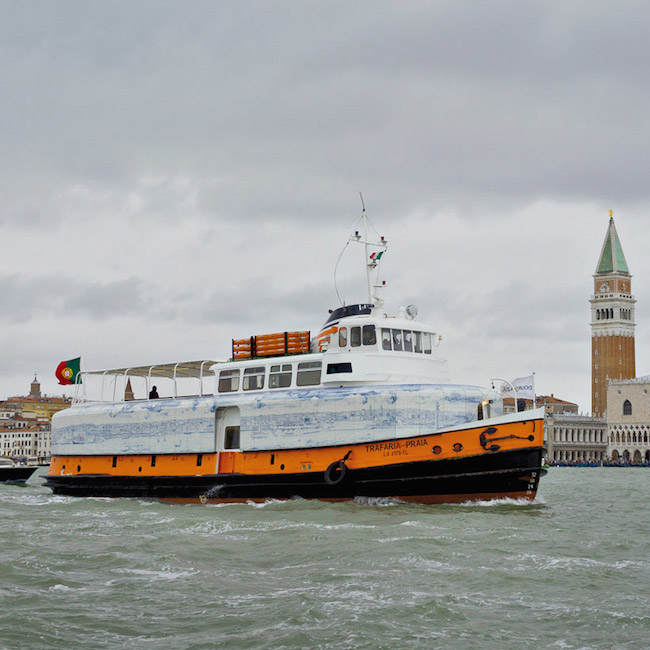VENICE — Fans of porcelain and installation art alike had something to be excited about when the good ship Trafaria Praia set sail in 2013. The work by artist Joana Vasconcelos was part of the Pavilion of Portugal at the 55th Venice Biennale. For one fantastic summer, visitors could ride the ship for free and enjoy a massive tile mural by Vasconcelos. The interior of the ship housed a piece of installation art in which the artist used textiles to create a whole environment that mimics blue and white tile. The latter is probably a little closer in material to the Vasconcelos works we’ve run previously on CFile.
The setting for the work was an old cacilheiro that was decommissioned in 2011. Through it, the artist links the cities of Lisbon and Venice, which share commonalities in water, navigation and the vessel. There’s also a link between the Venetian vaporetto boats and Portugal’s cacilheiros, both of them are vessels for commuters. In fact, Lisbon’s boats were the only means of public transportation between the city and its south bank. They remain a symbol of blue collar, working class people in Portugal. This also links the work to people in Venice who use ferries for public transportation.
As fans of Duchamp, it thrilled us to realize that the ship was one large readymade.
Vasconcelos is also presenting the Trafaria Praia as her art. Informed by Marcel Duchamp’s “assisted readymade,” she has changed the object without removing its functionality. On the outside of the ship, from prow to stern, she applies a large-scale panel of azulejos (tin-glazed, blue and white, hand-painted ceramic tiles) that reproduces a contemporary view of Lisbon’s skyline, from the Bugio Tower to the Vasco da Gama Tower. The work takes its inspiration from another large-scale panel of azulejos, the Great Panorama of Lisbon, which depicts the city before the legendary earthquake of 1755 and is a quintessential expression of the baroque-style golden age of azulejo production in Portugal. Vasconcelos has made other works that involve covering objects in azulejos; in doing this she evokes the material’s frequent deployment in architecture.

Joana Vasconcelos, Trafaria Praia, 1960 motor-driven steel passenger ferry, cork covering and furniture, 1430 x 750 x 3010 cm. Click to see a larger image.

Joana Vasconcelos, Great Panorama of Lisbon (21st Century), 2013, Viúa Lamego hand-painted tin-glazed ceramic tiles on a sandwich-structured composite panel, 220 x 6000 cm.
We love installation art for its ability to profoundly alter our sense of space, to make us question fundamental assumptions about our surroundings. In some cases, installation art is the closest we’ll ever get to standing on the surface of a different planet. Vasconcelos appears to be on the same page:
On the ship’s deck is an environment made of textiles and light. This also echoes past works by Vasconcelos, such as Contamination (2008–10) and the series Valkyries (2004–ongoing), in which organic, often colorful forms hanging from the ceiling interact with the surrounding architectural elements. This new work consists of a complex medley of blue-and-white fabrics all over the ceiling and walls, from which crocheted pieces, intertwined with LEDs, emerge to create a compelling effect. The installation suggests a surreal, womblike atmosphere or the deep ocean—something out of Jules Verne’s Twenty Thousand Leagues Under the Sea, perhaps, or the Bible story of Jonah and the Whale. It envelops visitors, eliciting both an intellectual and a sensorial response.
It almost goes without saying, but the scale of the work is superhuman. Not only did the artist tile an entire ship, but also all of the fabric in the installation was handmade. It’s a Herculean effort; a truly unique work of art.
As part of the project, Éditions Dilecta made a limited edition box set of Vasconcelos’ tile work, accompanied by a book. They came out in an edition of 100. Today those sets sometimes appear at auctions, with starting bids a little south of $2,000.
Do you love or loathe this massive work of contemporary ceramic art? Let us know in the comments.










Looks amazing! The amount of dedication and hope to see it when in Fienna this fall.
Hardly a readymade…More a vehicle. Duchamp’s readymades were unmodified objects from everyday life to which he appended his signature.
It is an “assisted” readymade.